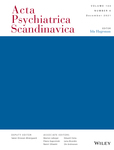Association of maternal and paternal personality disorders with risk of mental disorders in children: A nationwide, register-based cohort study of 1,406,965 children
Abstract
Background
Knowledge of the association between parental personality disorders and mental disorders in children is limited. To examine the association between parental personality disorders and the risk of mental disorders in offspring.
Methods
We linked Danish health registers to create a cohort of children born from January 1, 1995, to December 31, 2016. Children were followed until their 18th birthday, diagnosis set, emigration, death, or December 31, 2016. Parental personality disorders according to the International Classification of Diseases (ICD) Eighth or 10th Revision. Poisson regression analyses were used to estimate the incidence risk ratio (IRR) and cumulative incidence of ICD 10th mental disorders in offspring (age 0–17).
Results
The study cohort included 1,406,965 children. For girls, maternal or paternal personality disorder (MPD/PPD) was associated with mental disorders: MPD girls (IRR, 2.74; 95% CI, 2.59–2.89) and PPD girls (IRR, 2.10; 95% CI, 1.94–2.27). Likewise, the risk was increased for both MPD boys (IRR, 2.44; 95% CI, 2.33–2.56) and PPD boys (IRR, 2.04; 95% CI, 1.91–2.18). For girls and boys combined, exposure to two parents with a personality disorder was associated with the highest risk (IRR, 3.69; 95% CI, 3.15–4.33). At age 18, the cumulative incidence of any mental disorder in children of one or two parents with a personality disorder was 34.1% (95% CI, 33.0–35.1), which was twice the cumulative incidence of mental disorders in nonexposed children (15.2% [95% CI, 15.1–15.3]).
Conclusion
Children of parents with a personality disorder were at a 2 to 3.5 times higher risk of mental disorders compared with nonexposed offspring. Possible mechanisms of transmission of mental disorders from parent to child involve genetic, environmental, and gene–environment pathways. More research into these mechanisms and research into preventive interventions is warranted.

 求助内容:
求助内容: 应助结果提醒方式:
应助结果提醒方式:


